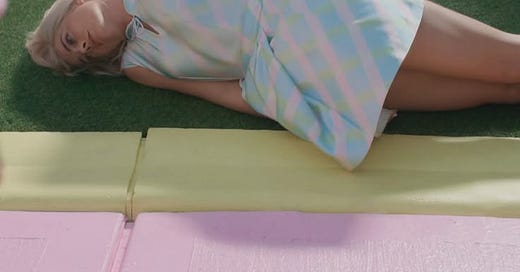Not you people-pleasing instead of actually doing what you want
Week 5: Bare Minimum Artist's Way
Welcome to Week 5 of The Bare Minimum Artist’s Way — our ADHD-friendly version of the 12-week course The Artist’s Way by Julia Cameron.
If you’re just landing here for the first time — welcome!
We’re suspending the dogma rules about morning pages and artist dates and doing the bare minimum with The Artist’s Way, because we believe half-assing it is better than giving up on Week 3.
Sound like you? Join us here on Substack and listen to our weekly companion episodes every Wednesday on Spotify and Apple Podcasts.
We often dismiss our creative urges with thoughts like, that’s never going to happen, this is taking too long, or this is too hard. These thoughts feel like hard facts, but really, they’re just flimsy little rooms we build around ourselves to feel safe.
And sure, we could open the door and step into the unknown, where mystery and synchronicity are waiting. But instead, we slam the door shut and call it “being realistic,” because staying where we are feels easier… at least on the surface.
The Threshold of Transformation
Week 5 of The Artist’s Way asks us to examine the sneaky little payoffs we get for staying stuck. Which feels counterintuitive—wouldn’t we want to grow? Wouldn’t we want to change, expand, and evolve? Isn’t that the whole reason we’re doing this???
“One reason we are miserly with ourselves is scarcity thinking. We don’t want our luck to run out.” (p. 92, for those playing along at home)
For many of us, suppressing creativity isn’t just frustrating. It’s suffocating.
We say we want growth, but when we hit the discomfort of the creative process—uncertainty, imperfection, the raw vulnerability of trying—we bolt.
Instead of sitting with the discomfort, we shut the whole thing down. I guess I’m not meant to do this! I’m just not that talented!!!! And just like that, we mistake resistance for a dead end instead of what it really is: the threshold of transformation.
Shaking the Apple Tree and Getting Oranges
We also think hustling is the only way to make things happen. We try to control every little detail, believing that if we just push hard enough, we can force the right outcome. And sure, effort is required. But as Cameron says on page 96, we shake the apple tree, and the Universe delivers oranges. Things rarely unfold the way we expect.
This is why balancing effort with openness is so important. We pray for it and dream about it, but when the thing we want shows up looking differently than we imagined, we reject it. But if we can remain open, it usually turns out better than we could’ve planned.
The dream job, relationship, or creative path may not look how we pictured, but the feeling it gives us is actually what matters.
Is This Play About Us?
The next section—The Virtue Trap—had us written all over it. If you’ve got a history of people-pleasing, listen up, buttercup.
Artists need downtime— not just a break from work, but a break from other people. Even the ones we love! And yet, we treat alone time like a luxury instead of a necessity. We hesitate, telling ourselves it’s selfish.
But when we don’t take it, everyone suffers. Our partners, friends, and coworkers feel the effects of our untapped dreams, overstimulation, and low-key resentment.
Cameron says that expecting ourselves to be creatively fulfilled without giving ourselves time and space is completely unreasonable. Yet, we act like creativity is an indulgence, something to squeeze in between obligations.
This Toni Morrison quote summarizes the sentiment beautifully (margins on p. 97):
“We’re traditionally rather proud of ourselves for having slipped creative work in there between domestic chores and obligations, but I’m not so sure we deserve such big A-pluses for that.”
In other words—why are we settling for scraps when we could give ourselves a feast?
The Trap of “Goodness”
We convince ourselves that prioritizing others makes us good people, that sacrificing our creative needs is noble. Cameron calls this “seductive faux spirituality,” the belief that depriving ourselves somehow makes us superior.
This is the starving artist mindset in disguise. It keeps us trapped in cycles of self-sacrifice, convinced that struggling makes us virtuous.
It doesn’t.
We have to unlearn the idea that suffering is proof of our worth, that struggling makes us better, and that our needs should always come last.
Because here’s the thing: every creative act is a domino. It may not seem like much in the moment, but it’s always leading to something greater. So why do we tell ourselves it has to be productive to be worthwhile? Why do we demand an outcome before we even begin?
At the heart of The Virtue Trap is people-pleasing. Our need to be liked, agreeable, and “nice” makes us betray our creative selves. We shrink. We comply. We suppress. And in doing so, we abandon the part of us that needs to create.
Breaking free from this means choosing ourselves, even when it feels selfish, ruffles feathers, and feels uncomfortable. Because protecting our creative time isn’t just about making art. It’s about protecting our creative spirit. And when we do that, we don’t just free our creativity— we free ourselves and those around us.
Want to follow along with us?
New podcast episodes & Substack articles every Tuesday!
👉 Subscribe to the Internet People podcast on Spotify or Apple Podcasts
👉 Subscribe for free on Substack to get the weekly articles:
Read the companion article for Week 6:










